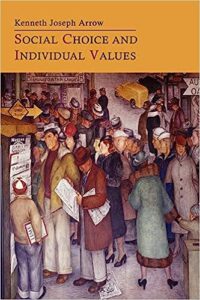Kenneth Arrow‘s impossibility theorem, a pillar of neoclassical economic theory, argues that under certain “seemingly reasonable” conditions, no social welfare function can adequately represent the preferences of society’s members. A social welfare function is a mathematical formula that combines individual preferences in some manner to reflect societal preferences. The impossibility theorem is sometimes colloquially understood as implying that aggregating individual preferences to form a social preference ordering is impossible. However, the restrictions Arrow placed for his theory to hold are far from reasonable, undermining the validity of his theorem.
Let’s take a closer look. One of the constraints Arrow includes in his theorem is the “independence of irrelevant alternatives” (IIA). This supposes that a person’s preference between two options shouldn’t be influenced by other choices. Essentially, it posits that preferences shouldn’t be dependent on any other alternatives becoming available.

Some economists have likened the IIA assumption to choosing amongst flavors of ice cream. Whether I prefer chocolate to vanilla ice cream shouldn’t depend on whether strawberry is available, or so it is argued. The ice cream metaphor is a poor one, however, given the trivial nature of the alternatives. So let’s break down the IIA assumption with another, more appropriate, example.
Suppose you’re torn between going out to party tonight and staying home to study for an exam. At face value, partying appears to be the more enjoyable option. However, a third option, like “getting into a good college,” may depend on your decision. Clearly, this third choice—the future consequence—ranks higher among your preferred alternatives than the immediate option to party. This is despite the fact that partying, when taken independently of future consequences, seems to be the preferred choice over studying.
Herein lies the problem with Arrow’s impossibility theorem: it overlooks long-term consequences and focuses too much on immediate gratification. This is troubling because much of today’s welfare analysis, including cost-benefit analysis, is based, at least indirectly, on Arrow’s theorem, leading economic theory broadly and public policy specifically to take a short-sighted approach.
Rejecting Arrow’s theorem shouldn’t be controversial. Nor should it be a politically divisive issue. Many from the political left already contest Arrow’s theorem and its rigid IIA assumption. However, those on the political right have been slower to disavow it, perhaps because of a natural skepticism toward a social planner dictating societal values through a social welfare function.

This is a mistake. Ironically, rejecting the use of any social welfare function at all, as some libertarians do, also implies rejecting the market process—which itself is guided by a social welfare function of sorts. Arrow himself acknowledges as much in his book that presents the impossibility theorem, Social Choice and Individual Values, when he concludes that “the market mechanism does not create a rational social choice.” Strangely, most libertarians have failed to heed the lesson.
Without the IIA condition, the impossibility theorem falls apart. The key takeaway here is that economists need to revisit some of their foundational theories. Indeed, much of modern welfare economics needs a fresh look and reevaluation. The mid-20th century, sometimes regarded as a golden age of economic theory, may well have been a breeding ground for economic errors. We need to rectify these, and a good starting point would be to revisit Arrow’s impossibility theorem.
James Broughel is a Senior Fellow at the Competitive Enterprise Institute with a focus on innovation and dynamism.


READER COMMENTS
David Henderson
Jul 16 2023 at 11:25am
Notice that the third choice you posit, getting into a good college, is not a choice. It’s a consequence of a choice and would be taken account of in the person’s choice between partying and studying.
James Broughel
Jul 16 2023 at 4:24pm
Indeed, a core point I am making is that Arrow’s theorem implies consequences don’t matter! The problem with IIA is it assumes choices have to be considered in pairs and any third choice is, by assumption, independent. But as you point out, there’s no reason to believe this independence assumption because many choices are contingent on others.
vince
Jul 16 2023 at 9:12pm
The ice cream cones can provide a good example. Say the clerk offers vanilla or chocolate. The patron chooses chocolate. The clerk then mentions strawberry. The patron switches to vanilla. Why? He likes chocolate a little more than vanilla, and vanilla a little more than strawberry, but he likes strawberry much, much more than chocolate. He switches to vanilla to minimize his regret.
robc
Jul 17 2023 at 10:04am
Individual preference is ordered, it won’t have loops like that.
Jon Murphy
Jul 16 2023 at 10:34pm
That’s not how I understand it at all. IIA can involve any number of choices. A third choice may or may not be independent. If it is independent, then it is irrelevant. If it is not independent, it is relevant.
I just don;t see how IIA and Arrow say consequences don’t matter. It seems to me the result of Arrow (the ever revolving outcomes) relies on the relevance of consequences from the choice process.
James Broughel
Jul 17 2023 at 8:21am
Arrow himself used the example of a candidate dying, and third party candidates are also commonly cited examples, where IIA applies. But my choice between candidates is not independent of the third party candidate being in the race. Maybe I prefer Nader over Bush because I know my vote for him will hurt Gore. IIA asserts such dependencies are irrelevant. IIA is best viewed as an extreme assumption about irrelevance, as opposed to having anything to do with independence. Just the name IIA is confusing.
On the pairwise comparison assumption, this is arguably the foundation of Arrow’s theorem: Everything can be broken down to comparisons between two. I see no reason why this assumption should be accepted either.
Jon Murphy
Jul 16 2023 at 11:27am
I don’t think your example of the party v. studying works well. “Getting into a Good College” isn’t an irrelevant alternative; it’s very relevant because it is tied to studying.
Further, I agree that IIA isn’t as fully reasonable as assumed in neoclassical economics, but I do think it’s useful in terms of a modeling assumption. It’s a helpful simplifying assumption. The problem arises when IIA becomes a normative judgement on the part of the analyst (such as in behavioral econ or a lot of “market failure” interventionist arguments). Given these models impose IIA as a normative condition (ie “people should act this way. If they do not, they are irrational, and therefore corrective measures must be imposed”), I think it’s reasonable to then analyze their aguments through the Arrow Theorem with IIA. It is one of the conditions they are imposing, and thus we can show under their own conditions their arguments frequently do not hold.
TL;DR: I agree with your thrust about tossing IIA, but let’s not toss the baby out with the bathwater.
Pierre Lemieux
Jul 16 2023 at 1:00pm
James: Your post raises very interesting and fundamental questions, but I would take (strong) exception with three of your points.
I would argue that Arrow’s Independence of Irrelevant Alternatives condition has nothing to do with an individual utility function (preferring college to parties, say), but with the assumed social welfare function. The condition says that, for example, if the voters would elect candidate A instead of candidate B, the fact that a third candidate, C, dies one week before the election is not going to change the voters’ choice for A. This assumption may be criticized but, I think, not for the reason you seem to suggest.
I don’t think it is true that cost-benefit analysis depends on Arrow’s theorem. It is rather the contrary: cost-benefit analysis is based on the negation of Arrow, that is, it is based on the existence of a social welfare function that would establish the desirability of a policy that provides a benefit of $100 to A at a cost of $50 to B.
Last but not least is James Buchanan’s argument. (I think it is the most important thing to understand, and I must confess it took me several decades to get there.) Buchanan forcefully argued against claims such as that “rejecting the use of any social welfare function at all, as some libertarians do, also implies rejecting the market process—which itself is guided by a social welfare function of sorts.” In reality, the market is the opposite of a social welfare function. It is difficult to discuss this in a short comment (although we must thank you for raising an opportunity to think about it). Perhaps I may quote from my article “The Impossibility of Populism” (which contains citations to Buchanan, including to his important 1954 JPE article):
James Broughel
Jul 17 2023 at 8:00am
These are great points Pierre.
On voting, I just don’t see why having one set of choices be contingent or dependent on another set of choices is a problem. But this seems to underlie the IIA assumption, be it at the individual choice level or the social choice level.
On Buchanan, he was right not to trust Arrow. But much like his work on cost, I find his thinking unhelpful on these topics. His main contribution seems to have been to sow confusion and, sadly, to spread anti-market bias.
Richard Fulmer
Jul 17 2023 at 4:35am
It seems to me that the claim that “rejecting the use of any social welfare function implies rejecting the market process” is a category error. Social welfare functions attempt to identify a collective preference, while market processes are aimed at satisfying individual preferences.
Moreover, as I understand it, Arrow’s theorem isn’t concerned with determining what is normatively best for “society,” rather its focus is on processes for determining voters’ preferences, regardless of whether the revealed preferences benefit or harm society.
Market processes enable individuals to act in their own best interests as they each perceive what is “best.”
Jon Leonard
Jul 18 2023 at 12:55pm
Arrow’s theorem is in many ways a math thing, and it’s important to apply it only to its appropriate preconditions. It only talks about aggregating ordered preferences; things like voting. If you’re doing something else (like aggregating preferences using pricing), it’s an entirely different endeavor and doesn’t apply. But where it does apply, it’s inescapable. Any system which just takes preferences in order and aggregates them has to have at least one of a list of quirks, IIA being one such. In a historical example, it’s plausible to argue that the presence of Perot in the 1992 election changed the outcome, without Perot actually having any chance to win. That’s IIA in action, and not so easy to dismiss as trivial. There are probably theorems of similar flavor covering more cases (even Range Voting is outside Arrow’s theorem), but critiquing Arrow’s theorem over things that it isn’t talking about is kind of silly. Critique people who misuse it instead.
Monte
Jul 18 2023 at 1:07pm
Your criticisms are valid, but to call them “economic errors” is, I think, a mis-characterization. Wouldn’t it be more accurate to say social welfare functions (like Arrow’s Impossibility theorem) suffer from shortcomings that render them less than ideal as exclusive policy-making tools? Nevertheless, as Jon Murphy points out, they are “useful in terms of a modeling assumption.” They take the world with all its nuance and complexity and reduce it to a theory in the form of a mathematical expression.
The same can be said of Pareto Efficiency, which, as a policy tool for efficiently allocating resources, fails to address the issue of fairness and distributive justice. According to UC Berkeley Law Professor Daniel Farber, “While much dispute exists about Kaldor-Hicks efficiency and about the relevance of distributional norms to law and economics, the Pareto principle is often taken by practitioners of law and economics as being beyond controversy.”
Arrow’s Impossibility theorem and Pareto Optimality remain viable models, but they shouldn’t be strictly relied upon to formulate social welfare policy.
Knut P. Heen
Jul 19 2023 at 8:51am
I don’t see the connection between the impossibility theorem and cost-benefit analysis. Cost-benefit relies on the Kaldor-Hicks. That is, if all the benefits go to person A and all the costs fall on person B, it still may be beneficial to do it because we may tax A and compensate B as the argument goes. Cost-benefit is usually to long-termish because they use too low discount rates (often the Ramsey-rate rather than the opportunity cost of capital). Moreover, when they include consumer surplus as a benefit, they should also include it in the opportunity cost of capital (the alternative project also produces consumer surplus beyond the return to investors; hence the appropriate opportunity cost of capital in a CBA is the sum of return to investors and consumers).
Finally, only individuals choose, there is no social choice. Social choice is just a name for another individual choosing instead of you. Just think about how you make choices in the family. Sometimes A get to choose, sometimes B, and so on. It is never we choose together unless everyone agrees (in which case it is still individual choice). Sometimes we may even use a coin toss to decide, but it is still individual choice because the individuals agreed to let the coin decide.
Comments are closed.